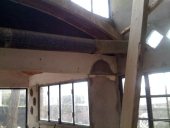posted 11 years ago
John Traynor : You have a very fertile Mind, and all of your adaptations from other builds you have seen are natural products flowing out from there !
Do you have previous Cob Experience ? The Type of Cob you have placed around the outside of your Firebrick heat riser is called Structural Cob, and is highly
insulating.
Because early on in a Rocket Stove build this is not a beginners technique, and there is a danger to the plumb and level-ness of your firebrick tower
most Rocket Mass Heater RMH Instructors would rather show the pour in Perlite and Cap with perlite and Clay Slip !
We DO NOT want to use Structural Cob to wrap around the horizontal piping of the Thermal Mass,it is too insulating, Instead using a straight 30% Clay
70% Sharp or Builders Sand this will also deal with moisture / high humidity swings better than cob with straw in it! (I THINK)!
The Structural Cob Should be saved to make a layer ~2''~ or 6cm thick as an outside layer around the Whole Cob Thermal Bench before the finish layer coat
is put on!
At the wall behind your RMH the use of An insulating reflective material is very much like what we want, a reflective barrier with a 4'' air gap both sides and
air exchange will serve you better !
I am not very concerned about too much Heat Energy radiating down through your Cob Thermal Mass Bench, But directly under the Rockets Burner Base,
and the Transitional Area, you you can have problems with the slow pyrolyse-ing or out-gasing of the wooden parts of your floor even at quite low temps, this
will eventually reduce the woods integrity, and lower the kindling temps to match light charcoal, though this will take decades, this is not a thing you want to
pass on with pride ! This does happen even faster to wood exposed to UV rays, or water damage and weathered to a uniform grey !
This is also a good place for air gaps by making brick channels underneath, and adding backer board and a reflection layer, even if it is only shinny side up cooking
grade Aluminum foil. This is also a good place for packed Perlite and Clay slip or Structural Cob, but I would hesitate to guess how thick it should be !
The Great Deliberative Minds that Run our Countries remind us that They must remain ever vigilant, that they 'have to be right every time', and 'the Bad Guys,only
once'.
You need to be prepared for the Storm of the Decade, that comes out of a different direction than the prevailing winds of a 'Normal Heating Season'! This could
easily cause the kind of backdraft issues that would make using your RMH difficult / impossible in the middle of a several day storm !
I highly recommend that you take the time to Google ''Stack effect'' and ''Whole House Stack Effect'', as a minimum, your chimney must be located higher than the
highest window that could be opened on your house, if you have attic vents with openings in your soffit and facia, and vents at your roof peaks, your minimum
just got higher! The builders recommendation would be 1.5 meters above the Peak !
This turned out to be a little more negative than I had intended, Again I am impressed with your 'thinking outside the box', we get stuck in our ways and want to
argue when people have radical new ideas, but people like you are the future of Rocket Mass Heaters Of all kinds ! I hope this is timely, and useful, send more
pictures ! For the Good of the Craft ! Big Al !
Late note : Is that bubble wrap up against your houses foundation, Next to last picture ?!! In the last picture I see what looks like a drier vent exit through the Wall,
While you are studying up on "Whole House Stack Effect'' you should be aware that It is likely that Running any power vented air exchange devices, driers, gas
hot water heaters, bathroom and kitchen vent fans can negatively affect your RMHs performance ! A. L.
Success has a Thousand Fathers , Failure is an Orphan
LOOK AT THE " SIMILAR THREADS " BELOW !


























































